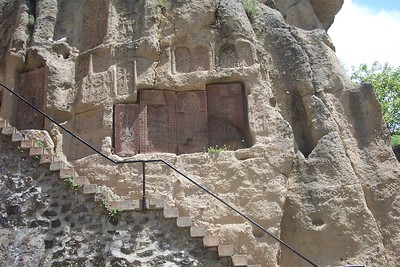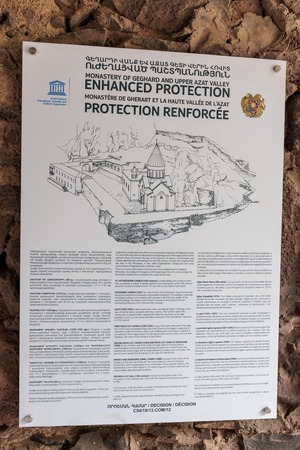Monastery of Geghard

The Monastery of Geghard and the Upper Azat Valley are renowned for their influence on Armenian monastic architecture.
The site contains a number of churches and tombs, most of them cut into the living rock. The monastery complex was founded in the 4th century by Gregory the Illuminator at the site of a sacred spring inside a cave. The main complex, situated within a defensive wall, dates from the 13th century and holds churches, chapels, cells for monks to live in, and princely tombs. The monastery had a school and library and was an important center of learning in the Middle Ages.
Community Perspective: An atmospheric site in a delightful deep valley. The buildings stand out for their delicate carvings. Geghard is a popular day trip from Yerevan, both with tourists and pilgrims.
Map of Monastery of Geghard
Community Reviews
Nan

Our half-day excursion from Yerevan led us to Garni and the Geghard Monastery. Like most visitors, we began at the reconstructed Garni Temple, which offers panoramic views of the Azat River Gorge. Continuing further up the gorge, we reached Geghard Monastery, nestled against the rugged cliffside.
Upon arrival, a short climb from the parking area brought us to the monastery gates. Here, visitors partake in a unique tradition: tossing pebbles at the cliffside. If a pebble adheres, a wish is granted. Beyond the gates lies a fortified 13th-century church, partially carved into the rock. The most captivating feature of Geghard is its intricate stone and rock carvings. Unfortunately, dim lighting during our visit hindered our full appreciation, but their craftsmanship was evident.
The site itself is compact and easily explored. Outside, the river gorge stretches, inviting further exploration. Regrettably, signposts and proper trails were lacking, limiting our hike beyond the monastery. While online images showcase breathtaking perspectives from higher vantage points, we couldn’t decipher the route.
During our summer 2023 visit, the monastery was undergoing renovations, and shrouded in scaffolding. Additionally, the site bustled with tour groups, dispelling any notion of remote isolation often associated with Geghard’s imagery online.
Getting There
Cab fares are low, making public transport or guided tours to Geghard unnecessary. An added perk awaits—a stopover at Garni, which, while not historically significant, offers picturesque photo opportunities and scenic vistas. Booking a cab via an app like Bolt proves the simplest choice.
While You Are There
As a dedicated World Heritage Site enthusiast, you’ll likely check off all the other Armenian WHS during your journey. It's entirely possible as day trips. Staying in Yerevan (as most travellers do), we found the city less enchanting than expected. For a livelier experience, consider venturing to Tbilisi, a vibrant gem in the region.
Alexander F. Somers
I was at Geghard in 1978.
When we (The lady I was with and myself) walked towards one of the cave entrances we heard the sound of a flute. While entering, the echo of sounds took us in such a way that we entered into the "room" with goose pimples on our body and tears in our eyes. An experience I'll never forget.
Note: At that time there still was a problem with exercising ones religion. This lady was playing Armenian Religious Music!
Els Slots

Geghard monastery has a great setting, amidst rocky mountains. The dark grey monastery is a popular day trip from Yerevan (often combined with the pagan-but-completely-rebuilt Garni temple), and also for school trips as I noticed. I took a guided tour here, which gets you more out of a visit (as displays in English or good guidebooks are non-existent).
Part of this monastery is hewn out of rocks (a bit similar to Lalibela). Inside, its rooms are dark, sober and cool. There are also caves left where monks prayed. Numerous khatchkars (stone crosses) are placed among the rocks.
What I liked best (besides the wonderful location) were the delicate carvings on the in-and outside of the main building. For example, the coat-of-arms relief in one of the rock churches. Also, the door in the main building is exquisite. There are a lot of Arabian influences in this work, telling another chapter of Armenia's turbulent history.
Solivagant

All 3 of Armenia’s WHS are churches or monasteries! Apart from “ticking off” additional WHS one must ask whether there is a great deal of extra benefit to be gained from chasing all 3 since the non-expert is probably not going to discern the differences in style. Indeed you will see many more than those on the WHS (and there are several more on Armenia’s “Tentative List” too!)
We did and have no regrets at doing so. The Armenian church lies at the heart of this country’s uniqueness (together it should be stated with its alphabet/language and the sense of “difference” and “oppression” which its geographical location and history of persecution and survival have given it) and seeing its monuments and the people worshipping in them is an essential part of gaining a feel for the country.
Each of the sites is in a different setting and Geghard’s is in a delightful deep valley. Dating from the 12th century the structure is half building and half cave. Its rural location was emphasised by the sellers of bread and fruit lined up outside and the slaughtered sheep hung up for skinning nearby. It was busy – but with Armenians on pilgrimage not tourists and a quiet reverence was maintained inside. The explanations of Armenian inscriptions and of saints with strange (to us) names largely passed us by but the atmosphere of peace and tranquillity stayed with us. (Visited July 2000)
Community Rating
- : Willc1515 Weecheng Sutul GZ Ljowers Fmaiolo@yahoo.com Mikita M WalGra Walter Rodinia Tarquinio_Superbo
- : Luke725 RobRos Stanislaw Warwas Kevin McFarland Roman Raab Lukasz Palczewski MoPython
- : Jungliemonkey BH Juropa Dutchnick Alexandrcfif CHJLondon History Fangirl Alexander Barabanov Alexander Lehmann Daniel C-Hazard Alex Christravelblog
- : Wojciech Fedoruk Philipp Leu David Berlanda Els Slots Adrian Turtschi GerhardM
- : Merveil Ivan Rucek Kurt Lauer Ronan B Vernon Prieto Cholden324 HaraldOest Afshin Iranpour Jon Opol Juha Sjoeblom Christoph Tingmelvin Dorejd Thomas van der Walt Kevin247 Mahuhe Tony H. Stanimir CugelVance
- : Luke LOU Solivagant Nan Martina Rúčková Jakubmarin
- : Yevhen Ivanovych
- : Csaba Nováczky Zoë Sheng
Site Info
Site History
2000 Inscribed
Site Links
Unesco Website
Official Website
Related
Connections
The site has 13 connections
Art and Architecture
Constructions
Geography
Religion and Belief
Science and Technology
Timeline
World Heritage Process
Visitors
228 Community Members have visited.
The Plaque
 (photo by Marco Schmidt)
(photo by Marco Schmidt)